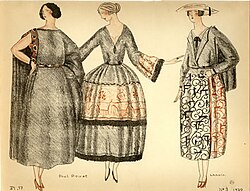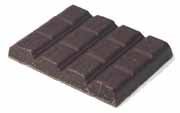Fashion design is the applied art dedicated to the design of clothing and lifestyle accessories created within the cultural and social influences of a specific time.
Fashion designers may work under their own name, for example Donna Karan, or for another Designer name or Brand. Designer brands which have a 'name' as their Brand such as Calvin Klein or Ralph Lauren are likely to be designed by a team of individual designers under the direction a designer director.
Fashion design differs from costume due to its core product having a built in obsolescence usually of one to two seasons. A season is defined as either autumn/winter or spring/summer. Fashion design is generally considered to have started in the 19th century with Charles Frederick Worth who was the first person that sewed his label into the garments that he created. Whilst all articles of clothing from any time period are studied by academics as costume design however only clothing created after 1858 could be considered as fashion design.

Fashions of 1915 by Poiret and Lanvin from
Le Bon Ton.
Couture beginnings
The first fashion designer who was not merely a dressmaker was Charles Frederick Worth (1826–1895). Before the former draper set up his maison couture (fashion house) in Paris, clothing design and creation was handled by largely anonymous seamstresses, and high fashion descended from styles worn at royal courts. Worth's success was such that he was able to dictate to his customers what they should wear, instead of following their lead as earlier dressmakers had done. With his unprecedented success, his customers could attach a name and a label to his designs once they learned that they were from the House of Worth, thus starting the tradition of having the designer of a house be not only the creative head but the symbol of the brand as well. (Foreshadowing another contemporary trend, the House of Worth remained in business long after its founder's death in 1895, continuing until Worth's great-grandson closed the house in 1952.)
Worth's former apprentice Paul Poiret opened his own fashion house in 1904, melding the styles of Art Nouveau and aestheic dress with Paris fashion. His early Art Deco creations signalled the demise of the corset from female fashion.
Following in Worth's and Poiret's footsteps were: Patou, Vionnet, Fortuny, Molyneux ( who taught Dior, Balmain and Lanvin ), Lanvin, Chanel, Mainbocher, Schiaparelli, Balenciaga, and Dior. Hand in hand with clothing, haute couture accessories evolved internationally with such names as Guccio Gucci, Domenico Dolce and Stefano Gabbana, Thierry Hermès, Judith Leiber, and others.
It was during this period that many design houses began to hire artists to sketch or paint designs for garments. The images alone could be presented to clients much more cheaply than by producing an actual sample garment in the workroom. If the client liked the design, she ordered it and the resulting garment made money for the house. Thus, the tradition of designers sketching out garment designs instead of presenting completed garments on models to customers began as an economy.
The early twentieth century
Throughout the 1920s and '30s, all high fashion originated in Paris, and to some extent London. American and British fashion magazines sent editors to the Paris fashion shows. Department stores sent buyers to the Paris shows, where they purchased garments to copy (and openly stole the style lines and trim details of others). Both made-to-measure salons and ready-to-wear departments featured the latest Paris trends, adapted to the stores' assumptions about the lifestyles and pocket books of their targeted American customers.
1940's and 1950's
Most fashion houses closed during occupation of Paris during World War II, and several designers including Mainbocher permanently relocated to New York. Nazi Germany continued to support some couture during the Occupation of Paris. Hollywood, largely underwritten by New York garment manufacturers, became the fashion focus during WWII. Paris recovered its primacy in the post-war era with Dior's New Look, but Paris was never the sole arbiter of trends again.
1960's and the rise of ready-to-wear
The rise of British fashion in the mid-sixties with ready-to-wear designers such as Mary Quant signalled a temporary end of French dominance. Taking their cue from street fashion, these designers catered to a younger consumer and offered retailers a new source of inspiration.
By the early 1960s, celebrities were becoming the new Fashion icons, even though they in turn wore designs from the couturiers of the day: influential "partnerships" of celebrity and high-fashion designer included Audrey Hepburn and Givenchy, and Jackie Kennedy and Oleg Cassini.
1970's
The decade began with a continuation of the hippie look from the 1960s. Jeans remained frayed and the Tie dye was still popular. The space age look was on the wane. Hems began dropping in 1974 to below the knee, until finally reaching the lower midcalf in 1977, called the midi skirt. Yves St Laurent introduced the peasant look in 1976 which became very influential. Skirts were gathered into tiers and shoulderlines dropped. Clothing became very unstructured and fluid at this point.
Punk as a style originated from London from the designer Vivienne Westwood and her partner Malcolm McClaren. Postmodernist and iconaclastic in essence this movement was a direct reaction to the economic situation during the economic depression of the period. Punk had at it's heart a manifesto of creation through disorder. Safety pins became nose and ear jewellery, rubber fetishwear was subverted to become daywear and images of mass murders, rapists and criminal were elavated to iconagraphic status. The trend dictation of the old couture houses was over.
1990's to present
Echoing the end of the 19th century, fashion at the end of the 20th century took on an ominous mixture of opulence and decadence, combined with a shared prospect of unavoidable radical change. The designer that best summed up this new mood was the British designer Alexander McQueen, His runway shows tackled themes that fashion had previous not embraced. These themes included rape, disability, religious violence, death and body modification. Models wore contatc lenses that blank out there eyes, or plaster neck braces and metal restraints that kept their bodies in rigid and painful poses.
This new mood was in dramatic contrast to the role and perception of fashion in the 1980's which was seen as being solely about status and power. Designer fashion now found itself aligned with contemporary artists including Damien Hirst, Tracey Emin and the Chapman Brothers. Other designers that were part of this movement included Martin Margiela, Hussain Chalayan, Jean-Paul Gaultier and Nicolas Ghesquière.
Fashion Education
Most fashion designers have attended art school. There are a number of well known fashion design schools worldwide. The most famous is Central Saint Martins College of Art and Design in London. Alumni of St. Martins include John Galliano, Alexander McQueen, Stella McCartney, and Hussien Chalayan. Other notable schools are Parsons The New School for Design in New York City, Royal Academy of Fine Arts in Antwerp, and The Royal College of Arts in London.
Income
Median annual earnings for fashion designers were $48,530 in 2000. The middle 50 percent earned between $34,800 and $73,780. The lowest 10 percent earned less than $24,710, and the highest 10 percent earned more than $103,970. Median annual earnings were $52,860 in apparel, piece goods, and notions--the industry employing the largest numbers of fashion designers.
Related terms
- Sewing Professional is the most general term for those who make their living by sewing, teaching, writing about sewing, or retailing sewing supplies. She or he may work out of her home, a studio, or retail shop, and may work part-time or full-time. She or he may be any or all or the following sub-specialities:
- A Custom Clothier makes custom garments one at a time, to order, to meet an individual customer's needs and preferences.
- A Custom Dressmaker specializes in women's custom apparel, including day dresses, careerwear, suits, evening or bridal wear, sportswear, or lingerie.
- A Tailor makes custom menswear-style jackets and the skirts or trousers that go with them, for men or women.
- An Alterations Specialist, or Alterationist adjusts the fit of completed garments, usually ready-to-wear, or restyles them. Note that while all tailors can do alterations, by no means can all alterationists do tailoring.
- Designers think up combinations of line, proportion, color, and texture for intended garments. They may have no sewing or patternmaking skills whatsoever, and may only sketch or conceptualize garments.
- Patternmakers flat draft the shapes and sizes of the numerous pieces of a garment by hand using paper and measuring tools or by computer using AutoCAD based software, or by draping muslin on a dressform. The resulting pattern pieces must comprise the intended design of the garment and they must fit the intended wearer.
- A Wardrobe Consultant or Fashion Advisor recommends styles and colors that are flattering for a client.
- A Seamstress is someone who sews seams, or in other words, a machine operator in a factory who may not have the skills to make garments from scratch or to fit them on a real body. This term is not a synonym for dressmaker. Seamstress is an old euphemism for prostitute. At the turn of the last century in Seattle, for example, 80% of the city's revenues came from taxes on sewing machines, which were placed in windows instead of red lights. No doubt respectable dressmakers and tailors had to sew in the dark.















